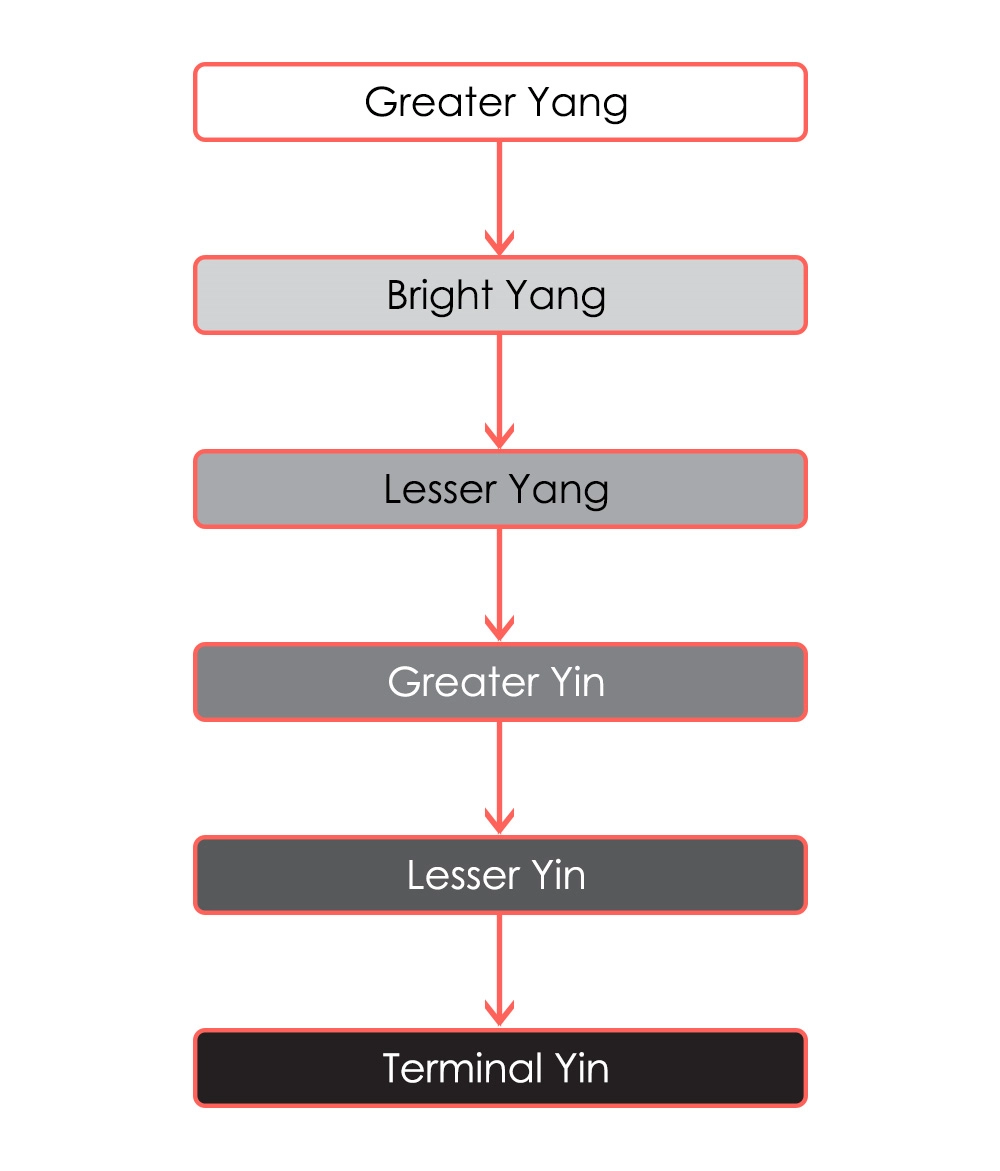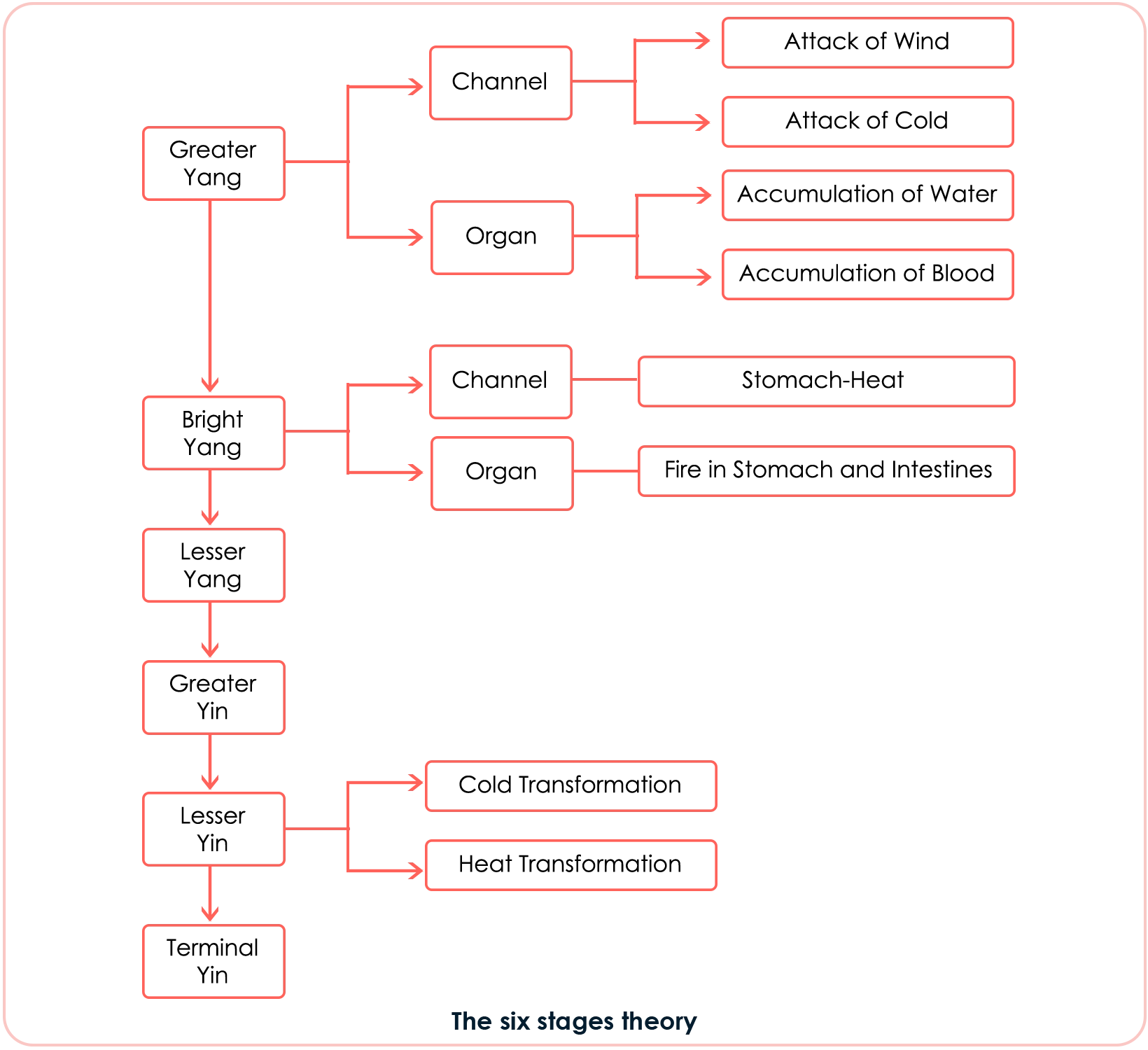
The six stages theory
Chinese: 六经辨证 Pinyin: Liù Jīng Biàn Zhèng
Summary: The six stages theory describes the progress of diseases caused by External Pathogenic Factors (mainly Cold), from the initial invasion at the three Yang stages to the subsequent degenerative consequences of the three Yin stages. It is now used as a way to classify and identify patterns of disharmony so as to treat patient conditions appropriately.
The six stages theory was developed during the Han Dynasty by Zhang Zhong Jing (AD 150-219).
Zhang developed the theory as a result of the tragic loss of three-quarters of his family from a plague. During that time, he observed the ineffective treatment of many of the herb doctors of the time, with their inability to effectively respond to the progression of acute diseases.
He wrote the theory in a book called "Discussion of Cold Damage" (Shang Han Lun 伤寒论), a highly revered work regarded as one of the first clinical manuals of Chinese Medicine. Many of the herbal formula from the book are extremely important and still frequently used to this day.
The Six Stages Theory is often contrasted with the Four Levels theory. While the former is mostly about diagnosing and treating diseases caused by External Cold, the latter describes the treatment of virulent diseases caused by External Heat.
The basic theory
The six stages theory mostly deals with Exterior invasions of Wind with Cold, although Zhang Zhong Jing's book does describe patterns of Wind-Heat as well.
It describes what happens as the invasion progresses within the body, through six stages of invasion, three Yang stages and three Yin stages.
The first stage, called Greater Yang, is the beginning stage and the only Exterior stage. At this point the Wind is still on the Exterior of the body and the Internal Organs are not affected.
Lessor Yang is at the half Exterior half Interior stage. All the other stages are characterized by the penetration of the pathogenic factor deeper into the Interior. In short as the disease progresses, it goes from relatively acute Yang stages to more chronic Yin stages.
Today it is more common to apply the diagnostic principles, treatment strategies and formulas of the Six Stages to the treatment of febrile, acute diseases. Chronic and degenerative diseases tend to rather be approached by other diagnostic strategies such as the Eight Principles or diagnosis based on the Zang Fu Organs.
The six stages

The Greater Yang stage (Tai Yang 太阳)
This stage occurs when the Wind is still on the Exterior of the body (although this stage does have two Organ patterns as well).
Symptoms are the result of an attack of Wind and Cold (or, more rarely, Heat and/or Dampness). The three key characteristic symptoms at this stage are headaches with accompanying neck and shoulder stiffness, aversion to cold and a floating pulse. It can also include general discomfort and pain as well as fever with chills characteristic of the early stages of cold and flu.
For such invasion to occur one already needs to be in a weakened state with one's pores (ruled by the Defensive Qi that controls their opening and closing) not able to sufficiently ward off external Pathogenic Factors.
This stage comprises four different patterns, depending on the location of the invasion and the symptoms (read more about each by clicking on the link):
Two of the patterns, Attack of Wind and Attack of Cold are purely on the Exterior.
The two other patterns are when the Pathogenic Factor has already reached the Organs (on top of also being in the Exterior) but only superficially. In both cases they affect the Bladder and in the case of Accumulation of Blood it's also present in the Lower Burner.
The Bright Yang stage (Yang Ming 阳明)
This stage, which can develop from both the Greater Yang and the Lesser Yang stages, is a penetration of an External Pathogen to the level of the Stomach and Large Intestine Channels.
If the invading Pathogen might have originally been Cold, this pattern is now resolutely characterized by Heat with symptoms such as fever, a preference for cold drinks and food, extreme thirst and excessive perspiration.
There are two types of patterns at the stage (read more about each by clicking on the link):
Stomach Heat is a so-called "Channel" pattern characterized by mere Heat. Fire in Stomach and Intestines is an "Organ" pattern that's more about Fire.
The key difference being that when there is Fire, the Heat is more intense and injures the Body Fluids, leading to Dryness.
The Lesser Yang stage (Shao Yang 少阳)
At this stage the External Pathogen has penetrated to the level of the Gallbladder and Triple Warmer Channels.
Its main characteristic is that it's a stage that oscillates between the Bright Yang and Greater Yang stages and alternatively takes symptoms from both. Such oscillations are characteristic of diseases like malaria and typhoid fevers that show alternating heat and chills, and a cyclic recurrence of symptoms.
Read more about the Lesser Yang stage here.
The Greater Yin stage (Tai Yin 太阴)
This is the first of the Yin stages. At this stage what's mainly affected is the Spleen Channel, often called "Lower Tai Yin".
In terms of symptoms patients typically experience classic signs of Spleen Yang Deficiency such as a feeling cold, a lack of appetite, diarrhea and fatigue.
Read more about the Greater Yin stage here.
The Lesser Yin stage (Shao Yin 少阴)
The Lesser Yin stage is a still deeper stage where the disharmony mainly affects the Kidney Channel.
The Kidneys are considered the root of Yin and Yang in the body. As such, this stage has two patterns (read more about each by clicking on the link):
They respectively describe respectively a Kidney Yang Deficiency (with Empty-Cold symptoms) and a Kidney Yin Deficiency (with Empty-Heat symptoms). Patients at this stage will experience either one.
The Terminal Yin stage (Jue Yin 厥阴)
The last Yin stage is where the disharmony is associated with the Pericardium and Liver.
The symptoms are a mix of Heat above (thirst, feeling of energy rising, pain and heat sensation of heart region) and Cold below (no desire to eat, cold limbs, vomiting).
The Terminal Yin pattern is sometimes seen in parasite infections such as roundworms.
Read more about the Terminal Yin stage here.
